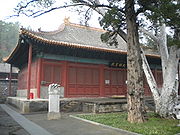
Fahai Temple
Encyclopedia


Ming Dynasty
The Ming Dynasty, also Empire of the Great Ming, was the ruling dynasty of China from 1368 to 1644, following the collapse of the Mongol-led Yuan Dynasty. The Ming, "one of the greatest eras of orderly government and social stability in human history", was the last dynasty in China ruled by ethnic...
Buddhist
Buddhism
Buddhism is a religion and philosophy encompassing a variety of traditions, beliefs and practices, largely based on teachings attributed to Siddhartha Gautama, commonly known as the Buddha . The Buddha lived and taught in the northeastern Indian subcontinent some time between the 6th and 4th...
temple located at the foot of Cuiwei Mountain, about two kilometers to the north-east of Moshikou, Shijingshan District
Shijingshan District
Shijingshan District is an urban district of the municipality of Beijing. It lies to the west of the urban core of Beijing, and is part of the Western Hills area...
, Beijing
Beijing
Beijing , also known as Peking , is the capital of the People's Republic of China and one of the most populous cities in the world, with a population of 19,612,368 as of 2010. The city is the country's political, cultural, and educational center, and home to the headquarters for most of China's...
, China
China
Chinese civilization may refer to:* China for more general discussion of the country.* Chinese culture* Greater China, the transnational community of ethnic Chinese.* History of China* Sinosphere, the area historically affected by Chinese culture...
.
History
Construction of the Fahai Temple started in the 4th year of reign of the Ming Emperor Zhengtong (1439 A.D.) and was completed in the 8th year of his reign (1443).Frescoes
The most distinguishing part of Fahai Temple is the Ming Dynasty frescoes. The total area of the frescoes is 236.7 square meters. Comparing with other famous frescoes in China, such as the Yongle Palace frescoes and the DunhuangDunhuang
Dunhuang is a city in northwestern Gansu province, Western China. It was a major stop on the ancient Silk Road. It was also known at times as Shāzhōu , or 'City of Sands', a name still used today...
frescoes, Fahai Temple's well-preserved frescoes are also notable in the depiction of figures, subtlety of patterns and the craft methods.

